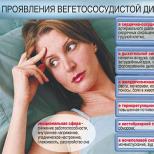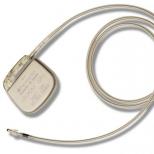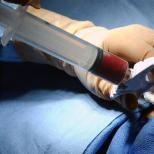How to deal with vegetovascular dystonia
Manifestations of vegetative-vascular dystonia are very diverse. Depending on the violations of the activity of one or another organ system, they are divided into several groups, although these symptoms can appear both in isolation and together:
cardiac (cardiac) manifestations - pain in the region of the heart, palpitations (tachycardia), a feeling of sinking heart, interruptions in the work of the heart;
respiratory (respiratory) manifestations - rapid breathing (tachypneous), inability to take a deep breath or vice versa, unexpected deep breaths; a feeling of lack of air, a feeling of heaviness, congestion in the chest; sharp attacks of shortness of breath, similar to attacks of bronchial asthma, but provoked by other situations: excitement, fear, awakening, falling asleep;
dysdynamic manifestations - fluctuations in arterial and venous pressure; disorders of blood circulation in tissues;
thermoregulatory manifestations - unpredictable fluctuations in body temperature: it can rise to 37-38 degrees C or drop to 35 degrees C and below.
the swings can be permanent, long-term or short-term;
dyspeptic manifestations - disorders of the gastrointestinal tract (abdominal pain, nausea, vomiting, belching, constipation or diarrhea);
sexual disorders, for example, anorgasmia - the absence of orgasm with continued sexual desire; various violations of the functions of the urinary system - frequent, painful urination in the absence of any real pathology, etc.;
psycho-neurological manifestations - weakness, lethargy, decreased performance and increased fatigue with a slight load, tearfulness, irritability, headaches, dizziness, increased sensitivity to weather changes, disturbances in the sleep-wake cycle, anxiety, startling during sleep, which most often occurs superficial and short lived.
Prevention and treatment of autonomic dysfunction should begin in childhood and adolescence. It is an erroneous opinion that autonomic dysfunction is a condition that reflects the characteristics of a growing organism, which eventually resolves on its own. It has already been proven that autonomic dysfunction that occurs in childhood or adolescence is an unfavorable background and a harbinger of many diseases. In adults, the presence of symptoms of vegetative-vascular dystonia requires, first of all, the exclusion of various diseases, the course of which is accompanied by impaired ANS function.
eat them various diseases of the endocrine glands (thyroid gland, adrenal glands, sexual disorders); many mental disorders (starting with neurosis, neurasthenia and ending with diseases caused by significant changes in brain structures). In addition, almost all chronic diseases are accompanied by symptoms of vegetative-vascular dystonia. That is why it is so necessary to contact a specialist in a timely manner. With the timely correction of vegetative disorders in 80-90% of women, sleep and appetite are normalized, many complaints disappear or are significantly reduced, and the adaptive capabilities of the body are restored. In the treatment of vegetative-vascular dystonia, non-drug methods are widely used: normalization of lifestyle, exercise therapy, country walks, tourism, spa treatment, tempering procedures, psychophysical training, outdoor recreation. The complex use of drugs, physiotherapy procedures is carried out according to the doctor's prescription.
answer.mail.ru
1Stress and other factors
No stress, no sickness. In the vast majority of cases, it is stress, chronic overwork, depression, conflict situations that trigger certain negative mechanisms in the specialized parts of the limbic system of the brain. In simple terms, the nervous system cannot cope with stress, and other systems of the body suffer from disturbances in the functioning of the nervous system, in particular from a violation of the regulation of vascular tone, and VVD develops. In addition to stress, the causes of VVD in adults can be infections of the upper respiratory tract, especially long-term and sluggish.
You can not independently treat sinusitis, tonsillitis, ear pain. Incorrectly selected treatment can start the chronicity of the infection and, as a result, “acquire” in addition such a disease as neurocirculatory or vegetative-vascular dystonia. Also, the causes of the onset of the disease include trauma to the skull, hormonal disorders, excessive alcohol abuse, nicotine addiction, hereditary predisposition, physical inactivity, or a sedentary lifestyle.
2 Who is diagnosed with VVD more often?
Every adult is subject to stress to a greater or lesser extent. But people with a certain type of character and age get sick with VVD more often. Who most often goes to the doctor with symptoms of vegetative-vascular dystonia? Numerous studies have shown that women and adolescents are most susceptible to VSD. The nervous system of adolescents is extremely labile, often young boys and girls are not able to cope with nervous tension.
Among women, the vulnerable, responsible, taking everything "close to heart" are more susceptible to VVD. But it cannot be said that VVD is a disease exclusively of the “weaker” sex and adolescents. Men also go to the doctor with symptoms of vegetative-vascular dystonia. The doctor establishes this diagnosis only after a thorough examination of all organs and systems, excluding a similar pathology of the internal organs.
It is impossible to make a diagnosis of "vegetative-vascular dystonia" at the first visit to the doctor without data from laboratory and instrumental studies! A patient with a presumptive diagnosis of VVD is prescribed a comprehensive examination. And only after the exclusion of organic pathology of internal organs and systems, this diagnosis can be made.
3Main symptoms and complaints in VVD
There is no such disease that could surpass VVD in the number and variability of symptoms. But all the symptoms and complaints for a long time do not have an organic pathology. Over time, the disease aggravates its course, and morphological changes in internal organs and systems appear, so you should not try to cure VVD on your own or wait until it “passes by itself”. To overcome the disease, you need the help of a doctor. What symptoms and complaints make it possible to suspect VVD?
- Cerebral manifestations:
- headache. Its intensity can be different: from paroxysmal, like with a migraine, to aching, insignificant. Often, a headache with VVD is confused with migraine, because, like with migraine, it can be accompanied by tinnitus, nausea and even vomiting, high sensitivity to bright light, sounds. In this case, a qualified neurologist will help to exclude migraine;
- attacks of dizziness, the intensity and duration of which vary significantly with VVD: from mild dizziness to attacks of dizziness of such intensity that prevent the patient from working and even disrupt their usual lifestyle;
- tinnitus is another symptom of brain disorders in VVD;
- Cardiovascular manifestations: pain in the heart, “fading” or “failures” in the heart, palpitations, or vice versa, rare heart contractions. A feature of pain in the heart with vegetative-vascular dystonia is that it disappears with distraction, switching the patient, as well as its subsidence after taking sedatives;
- Psycho-emotional manifestations: irritability, fatigue, tearfulness, aggression, tendency to depression and aggravation of symptoms. Patients are often sure that all attempts to defeat the disease are futile, that they are seriously ill, and their condition will only worsen. The highest manifestation of disorders in the psycho-emotional sphere is the development of panic attacks;
- Respiratory manifestations: complaints of difficulty breathing, shortness of breath, sore throat, sensation of a lump, a foreign body when swallowing;
- Manifestations of gastrointestinal dysfunction: loss of appetite, nausea, a tendency to constipation, or vice versa, increased stool, increased gas formation, hypersalivation.
This is only a small fraction of the symptoms and complaints that are most common when patients visit a doctor with a diagnosis of "vegetative-vascular dystonia". Each person should understand that when the above complaints appear, one cannot wait “until it passes by itself”, it is better to consult a doctor as soon as possible. Early treatment, competent treatment of VVD increases the chance to relieve symptoms and forget about the diagnosis forever after treatment.
4How and how to treat VVD?
When the diagnosis of vegetative-vascular dystonia is established, it is necessary to decide on the tactics of treatment. Correctly prescribed complex treatment will help to overcome the disease. Therapy for VVD can be both pharmacological and non-pharmacological. The methods of non-drug therapy of neurocirculatory dystonia include: normalization of the regime of work and rest, rational, balanced nutrition, psychotherapy, hardening, contrast showers.
It is useful to take a contrast shower as a remedy for VVD to strengthen immunity, improve blood flow, and activate metabolic processes. The technique of conducting a contrast shower is as follows: water procedures begin with a warm water temperature that is comfortable for the body, which is then raised to hot, after which the water temperature is made cool. A contrast shower with VVD helps with headaches, dizziness, tinnitus, and cardiac symptoms.
It is important to do a contrast shower correctly and remember about its contraindications: heart disease, high blood pressure, tumors, thrombophlebitis. If there are contraindications, this procedure cannot be done.
If it is impossible to do without drugs in the treatment of vegetative-vascular dystonia, then the doctor connects drug therapy. What medications, how long to take them and in what dosage, only the doctor decides. You can not independently make adjustments in treatment or cancel it. This can only harm your body. Only a doctor knows how to cure VVD, do not self-medicate!
5 Medicines for VVD
Medications for vegetative-vascular dystonia are divided into groups, depending on the main effect they have. Medicinal products of plant origin (valerian, motherwort, novo-passit) have a calming, sedating effect. It is recommended to drink them for at least a month, a lasting effect from taking occurs after 5-7 days. Form of administration - tablets, infusions, tinctures. You can do soothing baths with the addition of herbs valerian, mint, calendula.
Antidepressants help with depression, including hidden ones, to which patients with VVD often suffer. This is a group of drugs that eliminates depression and helps the patient get rid of its symptoms forever. Antidepressants include the following tablets: amitriptyline, imipramine, teralen and others. Nootropics are a group of drugs that improve metabolic processes in brain cells. These include cerebrolysin, piracetam, picamilon, ceraxon.
Piracetam increases oxygen saturation of the brain cells, as well as heart cells, reduces tinnitus, dizziness, headache with VVD. The course of treatment with nootropics is from 3-4 weeks to 2-6 months, if necessary, it can be repeated after 2 months. Antioxidants are a group of drugs that are successfully used for VVD. One of the representatives of antioxidants is mexidol.
Mexidol helps brain cells cope with hypoxia, protects them from toxic metabolic products. Meskidol also has anti-anxiety activity, improves memory. Mexidol is produced in the form of an injection solution. In addition to mexidol, antioxidants include eltacin, succinic acid, and vitamins.
6Methods from the people in the treatment of VVD
It is worth noting that today the traditional methods of treating VVD do not lose their relevance. Clay treatments, warm mustard baths, propolis and honey infusions are popular among patients. Treatment of VVD at home with folk remedies is justified only if these methods of treatment are not contraindicated for a particular patient. Therefore, before using non-traditional methods of treating VVD, it is necessary to consult a doctor.
zabserdce.ru
VVD treatment
Vegetovascular dystonia or VVD is a complex of symptoms that are different in nature and manifestations. A decisive influence on the development of the clinic has a change in vascular tone and a violation of the blood supply to their basin.
At the heart of the manifestation of VVD symptoms is a violation of the regulatory functions of the autonomic nervous system. There are two main mechanisms for the development of VVD:
- Increased activity of regulatory systems in the brain;
- Hypersensitivity of peripheral receptors of body structures.
To the question of whether it is possible to cure VVD forever, there is no definite answer. The tactics and outcome of therapy depend on the form of the disease and its clinical course. The symptoms of the disease are different and their treatment is aimed at correcting the secondary consequences of the pathological process.
The clinical course of the disease depends on whether vegetovascular dystonia and its dominant symptom are treated or not.
Relief of an attack of VVD
VVD as a disease is manifested by the development of panic attacks or seizures. Attacks begin unexpectedly both for the patient and for others. The relationship of seizures with the action of any factor is not detected.
The fight against VSD begins with the reduction of panic attacks and the prevention of their occurrence. Get rid of panic attacks should be with the most gentle method of treatment.
First aid for the development of a panic attack is aimed at normalizing the patient's condition. This eliminates all irritating factors. The patient is asked to calm down and relax.
The clinical picture of an attack develops due to dysfunction of the autonomic nervous system with the involvement of certain body structures. The severity of the symptoms and the clinical picture determines how to deal with VVD and its attacks.
Each patient can find his own way to relieve an attack and get rid of vegetovascular dystonia.
Very often, seizures stop on their own. After successful treatment of a panic attack, patients can hear the phrase: "I got rid of the VSD" or "I got rid of the VVD." By reducing the number of attacks, people get rid of the main symptoms of VVD.
It is possible to cure vegetovascular dystonia by reducing the main seizures or panic attacks. At the same time, it is unlikely to permanently get rid of vegetovascular dystonia under the influence of causative factors.
The use of drugs for VSD
Drug therapy is aimed at eliminating the provoking factor and its role in the pathogenesis of VVD. In this case, symptomatic therapy of the main signs of the disease is carried out.
Medicines of various action and composition are used. Drug therapy is used for long courses of up to six months or more, which negatively affect the function of the liver and kidneys.
Before using the medicine, you must carefully read the contraindications. Begin therapy with low doses, gradually increasing to a maintenance dose.
In the treatment of symptoms of VVD, the following drugs are used:
- Adrenoblockers;
- Drugs that improve tissue trophism;
- nootropics;
- Antispasmodics;
- Tonic drugs;
- Sedatives.
Removing symptoms or minimizing them does not mean a complete cure for the disease. It is possible to overcome VVD only by a complex method, which is aimed at eliminating the main cause of the development of panic attacks.

It has been established that pathological changes occur in the central nervous system in vegetovascular dystonia. The pathogenesis of the development of the disease is associated with the exchange of serotonin in the brain tissues, therefore, VVD is treated with a group of centrally acting drugs:
- Antidepressants increase the reuptake of serotonin by nerve cells;
- Tranquilizers for the correction of mental disorders.
The duration of treatment and its effectiveness in each patient is different. Tranquilizers show their effectiveness only with prolonged use. The average course of therapy is 6 months.
Sometimes VVD is not treatable with medications. In such cases, resort to non-drug treatment.
Vegetovascular dystonia can be cured using the following methods:
- Psychotherapy;
- Physiotherapy;
- Massage;
- Breathing exercises;
- Acupuncture;
- Physiotherapy.
Symptoms of VVD are perfectly treated with simple methods aimed at developing a person's ability to relax and abstract. Indeed, more often they get rid of the disease through an individual approach to stopping seizures.
Many patients in the story "how I got rid of VVD" give completely simple and uncomplicated examples. Some people find yoga or swimming helpful. Therefore, how to cure dystonia, everyone must determine for themselves.
Unconventional treatments should be tried first, and serious drug therapy should be resorted to only in extreme cases.
Psychotherapy VVD
Separately, it is worth dwelling on the method of psychotherapy. This method allows you to fight the disease without the use of pills. The main goal of psychotherapy is to establish personal deep contact with the patient.
Psychotherapy is aimed at influencing the entire body through the human psyche.
Psychotherapy is carried out by doctors with higher medical education or psychologists with training in psychotherapy. The appointment of a psychotherapist has nothing to do with psychiatry. Psychotherapy deals with the treatment of somatic pathologies through the human psyche.
For people with vegetovascular dystonia, individual sessions with a psychotherapist will be most productive. Classes are a conversation with a doctor in a relaxed atmosphere.
During the appointment, the specialist conducts a qualitative psychoanalysis of the personality. Psychoanalysis includes a brief description of the patient in emotional terms.

To identify the problems of panic attacks, it is recommended to analyze the following situations:
- Time of occurrence of attacks;
- duration of clinical manifestation;
- The presence of provoking factors;
- The possibility of stopping an attack under any circumstances without the use of drugs;
- The frequency of attacks in qualitative and quantitative terms.
Sometimes even an insignificant detail, which in a normal setting goes unnoticed, helps to get rid of vegetovascular dystonia.
For example, the patient in the analysis notices that the attacks become more pronounced when the duration of a night's sleep is less than 6 hours. Elimination of the provoking factor by normalizing the regimen of the day and rest leads to a significant reduction in seizures.
Key psychotherapist tips for reducing panic attacks:
- Develop a specific behavioral algorithm when an attack occurs;
- To calm down, use breathing exercises to restore normal tissue oxygenation;
- During an attack, try switching to something else;
- Use relaxation techniques to prevent an attack from developing.
Another advantage of psychotherapy is the development of the body's ability to relax in stressful situations. Each attack is a certain stress for the body. The stress chain in the body under various factors operates according to one mechanism.
An important regulator in the body is mental function. The main thing is to realize the concept of "everything depends on me." If you keep your behavioral reaction under control, then you can cope with the attack yourself.
Treatment prognosis
Many are concerned about the question of how to cure VVD completely. For each patient, the answer to this question is different. It all depends on the clinical picture of the disease and the individual characteristics of the organism.
After successful drug or non-traditional treatment, some preventive measures must be followed for the occurrence of panic attacks.

The following series of preventive measures effectively fights dystonia:
- Exclusion of stressful situations;
- Normalization of sleep;
- Fight against bad habits (alcohol, smoking);
- Reception of vitamins and microelements;
- Sports activities or ordinary walks in the fresh air;
- Aromatherapy or other relaxing treatments.
With the successful treatment of the symptoms of dystonia and its attacks, you must be wary of your health. For a long remission period, it is best to take precautions and avoid exposure to a provoking factor.
Everyone can count on a favorable outcome of the disease, regardless of the severity of the symptoms. With vegetovascular dystonia, it is possible to get rid of its symptoms forever with early diagnosis and an effective integrated approach to treatment.
distonia.ru
Symptoms of dystonia
This disease is more susceptible to modern young people who lead an active lifestyle. They begin to notice strange symptoms in themselves: they are worried about a rapid heartbeat, drops in blood pressure. This is accompanied by a breakdown, increased weakness, a state of anxiety.
Such people are characterized by increased irritability, incomprehensible inner restlessness, frequent fainting. Often patients suffer from headaches, hot flashes or colds, panic attacks. Gradually, the symptoms intensify, begin to affect the lifestyle and work capacity of the patient. Consultations and examinations by doctors usually do not give a quick result. All indicators of the body are within the normal range, but the patient continues to feel unwell, and the fact that doctors cannot find the cause of this is especially disturbing.
The cause of this disease may be associated with hormonal disruptions or changes in the body. More often adolescents, young women after breastfeeding, women in menopause suffer from vegetovascular dystonia. Some patients suffer from this disease since childhood, which may be due to frequent stress, unbalanced diet and poor lifestyle.
Treatment of dystonia
For the successful treatment of this disease, the internal mood of the patient plays an important role. To reduce the manifestations of dystonia, you should try to avoid stressful situations, respond to them with restraint. You should not get hung up on your feelings, in such situations it is useful to be distracted by something interesting, to relax more in the fresh air, to travel.
It is also important to review the diet: you need to include foods containing potassium and magnesium, which are necessary to strengthen the cardiovascular system. These include dried apricots, raisins, walnuts, bananas. Do not neglect buckwheat, eggplant. Useful carrots, green and onions, garlic, fish and seafood. With a frequent increase in blood pressure, you do not need to get involved in drinking coffee, it is better to drink green tea, milk, kefir, freshly squeezed juices and fruit drinks. The volume of liquid should be 2-2.5 liters per day. Fatty, salty, pickled and smoked foods should be abandoned.
To normalize the tone of the body, a contrast shower, a visit to the bath, a tonic massage of the shoulder girdle helps. If it is not possible to take a contrast shower, you can use contrast baths for hands and feet, but the body should be accustomed to such procedures gradually.
With vegetovascular dystonia, drugs are used, such as Corvalol, Valocordin, tincture of valerian, motherwort. In some cases, doctors prescribe antidepressants Paroxetine, Fluoxetine. If necessary, tranquilizers are used for treatment. In addition to the main medicines, it is useful to take the Neuromultivit multivitamin, drugs that improve cerebral circulation - Nootropil, Piracetam.
Medicinal herbs give a good effect: you can use, like tea, infusions of oregano, horse chestnut, motherwort, mint, hawthorn, St. John's wort 1/3 cup 3 times a day. An important role in the successful treatment of vegetovascular dystonia is played by the mental state of the patient, so he must be tuned in to recovery.
aortic stenosis




